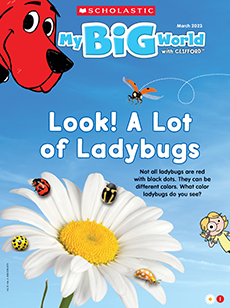Good Morning, Groundhog! Lesson Plan
What We Are Learning
Science Focus:
groundhogs/animal behavior
Theme Vocabulary Words:
groundhog, sniff, nibble, whistle, burrow
Skills We’re Practicing:
group discussion, critical thinking, vocabulary, grossmotor skills, counting/number recognition
- Grumpy Groundhog by Maureen Wright tells the story of a groundhog who refuses to come out of its burrow on Groundhog Day. How will the people of the town get it to emerge? As you read this story with your students, encourage them to share their own ideas—what would they give the groundhog to convince it to come out?
Build a Groundhog Burrow
Materials: small paper bags, toilet paper tubes, paper towel tubes, scissors, tape, paper, crayons
- This STEM activity is a wonderful way to explore engineering concepts.
- In advance, cut holes in some of the bags and tubes. You could also cut the ends of some of the tubes so they fit together.
- Display the picture of the burrow from the issue. Ask children to share what they notice about it. Together, discuss the features of a groundhog burrow. Then tell children that they’ll be building their own groundhog burrow!
- Put children together in pairs or triads, and give each group some paper bags and tubes. Encourage children to plan by drawing pictures of how they want their groundhog burrow to look. Then build!
- When children are done, provide an opportunity for each group to share their creation. How are the burrows alike? How are they different? engineering/collaboration

Materials: flashlight, long table or something else to crawl under
- Your students will enjoy pretending to be a groundhog when playing this game!
- Gather children on the rug, and tell them the legend of Groundhog Day. Every year on February 2, a groundhog pops out of its burrow. If it sees its shadow, there will be six more weeks of winter. If it does not see its shadow, spring is near! Tell children that with this game, they will get to be the groundhog!
- Have children line up behind a long table or something they can wiggle through and under. (This is the “burrow.”) Dim the classroom lights and stand at the other end of the burrow, flashlight ready.
- One by one, children will crawl through the burrow one by one. As children come out the other end, shine the flashlight on some but not on others. Your little groundhogs can predict the weather depending on whether they saw their shadow or not! gross-motor skills/observation
